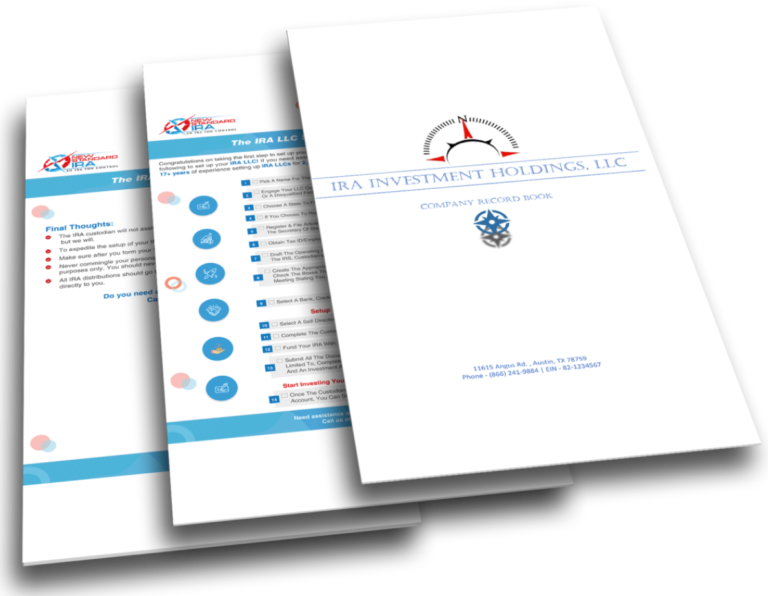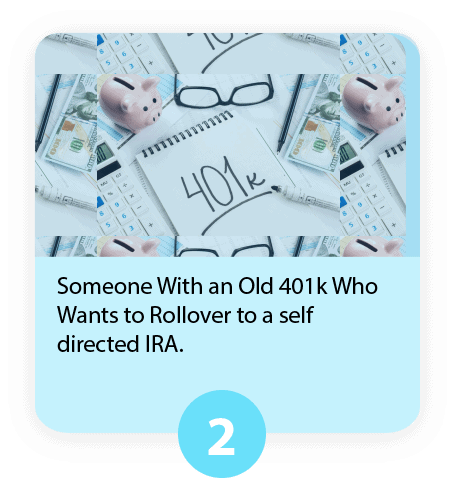
Cryptocurrency in Your IRA
Cryptocurrencies like Bitcoin, Litecoin, Ethereum, Ripple, etc … are all the rage these days and millions of Americans are trying to figure out how to add this new digital currency to a retirement savings portfolio.
Get ultimate control of your IRA investing experience with an IRA LLC! With an IRA LLC, you can truly diversify your IRA and buy real estate, bitcoin, cryptocurrency, and precious metals, and so much more, all without the hassles of dealing with your IRA custodian and without paying their onerous fees.
We offer you security versus the illusion of safety, flexibility versus regulated savings, and simplicity in a complex world!
- Welcome to the New Standard of IRA Investing!

We Can Help You Set Up Your IRA LLC The Right Way The First Time. Benefit From Our 19+ Year Track Record, Proven Process, And Done-For-You Service. We Can Help You As Much, Or As Little As You Need.
After Your IRA LLC Is Set Up, You Call The Shots!
With An IRA LLC, You CAN…


Whether it is bitcoin or another
cryptocurrency you have an eye on, you can purchase them in a New Standard IRA without the need for custodial consent. Transition to a TRULY self directed IRA, chart your course.
Purchase physical gold, silver, & other scarce, rare, precious metals in your IRA. Unshackle your IRA from tradition, preserve your wealth and build a truly diversified retirement portfolio that includes physical precious metals.


Embark on a transformative journey with us, where your financial aspirations meet limitless possibilities. Our mission, since 2006, has been to empower you to swiftly set up an IRA LLC so that you can benefit from the myriad freedoms offered within the IRA rules.
Picture yourself in the driver’s seat of our proven IRA LLC model, with our team of self-directed IRA experts ensuring the engine runs smoothly throughout your journey. Unlike conventional IRA custodians, who drown clients in regulations and fees, the IRA LLC liberates you from such constraints. We aim to significantly lower your costs, enhance your overall investment experience, and reduce your overall cost of ownership.
This is more than a journey; it’s a partnership in your pursuit of a better financial future.
Let our combined expertise and commitment guide you toward a future where your decisions shape your financial landscape. The path awaits—are you ready to embark on a journey where empowerment, growth, and achievement become your constant companions?







Watch This Video Now!

Take Advantage of Our Done-For-You IRA LLC Solution!
Set Up Your LLC with the appropriate operating agreement.
Choose an IRA custodian who allows you to invest in an LLC.
Properly Capitalize Your New IRA Account And Make Sure To Avoid a Taxable Event.
Set up Your Checking Account in The Name of The Newly Formed LLC & Fund Your Account.
Once your IRA LLC account is funded, you can invest HOW you want and WHEN you want in an “IRA YOU Control!” With a New Standard IRA, you have decision control and checkbook control, and what you can invest in with your retirement account is nearly unlimited.
You can invest in any asset NOT explicitly prohibited by the IRS. Are YOU ready to take control of your IRA retirement account and leverage this advantage? If so, we can help you!
We offer a turnkey, done-for-you IRA LLC service that ensures you set up your IRA LLC the right way the first time. With our proven step-by-step process, we can help you get up and running as quickly as possible versus wasting months of your own time trying to figure everything out on your own.
Save Yourself The Hassle & Take Advantage of Our Done-For-You
Service Today!


First of all, we aren’t surprised by this question. It is our #1 asked question.
Truth be told, banks and IRA custodians’ goals are in opposition to yours.
Banks and custodians who service your IRA don’t have financial incentives to help you diversify beyond traditional investments.
The common misconception of an individual retirement arrangement (IRA) is that you are confined to a small subset of investments, and you can only invest in stocks, bonds, mutual funds, annuities, or certificates of deposit (CD).
However, the exact opposite is true! Allow us to let you in on a little secret that is nearly half a century old. When the Employee Retirement Income Security Act (ERISA) passed in 1974, this provision opened the door for investors like you to open a New Standard IRA.
Still, banks and custodians continue to profit from you by tacitly misleading you to a small corral of investing options under their control. These institutions offer you the illusion of diversification, all the while milking your IRA over time with hidden, burdensome fees, which decimate your ROI.
The good news is there is only a one-time investment to set up your New Standard IRA. Our done-for-you solution starts at just $400*.
Your investment varies depending on your desired objectives. Most of our clients need to get up and running quickly and truly appreciate the work we’ve already done for them, while others don’t mind spending additional time and money working with a local CPA or attorney to figure it all out for them.
We’ll help you as much or as little as you like, giving you the widest range of options.
Note: This fee does not include State filing or custodial fees associated with filing your LLC, etc. We pair you with the lowest flat-fee custodial services in the industry … guaranteed. We have already done all the work for you, so you don’t have to!
If you are comfortable writing checks and balancing a checkbook, you can manage a New Standard IRA.
After setting up your New Standard IRA with our done-for-you service, you will experience a new level of freedom. You likely say to yourself, “Why didn’t I move on this sooner?”
After structuring your IRA account, it will be much easier for you to manage your retirement and financial future.
Just imagine what investing will be like when you can seamlessly make IRA investments by simply writing checks right from your IRA account without having to complete mountains of paperwork, waiting for approvals, no custodial interference, and bureaucratic red tape!
Are you ready to enjoy all the amazing benefits of worry-free, hassle-free investing? You can rely on us to help you set up your IRA to reach your personal retirement and investment goals.
Q: What Makes a New Standard IRA Different From a Standard IRA?
In a New Standard IRA, you eliminate the custodian from controlling the investment process, obstructing your investment activity along with their associated fees that decimate your ROI.
You receive total management control to direct your IRA’s investment activity. You also receive checkbook control of your IRA account, which means when you are ready to invest, you simply pull out your bank debit card or write a check for your investments right from your IRA account.
Self Directed IRA Custodians
Self directed IRA custodians will allow you to make some alternative investment transactions in your IRA, but you still don’t have complete control of your IRA investing experience.
When your park your funds with a self directed IRA custodian, you are essentially self directed in name only. The custodian remains in control of when, how, and what you can invest in inside your IRA.
When You Invest
What You Invest
How You Invest
However, with a New Standard IRA, you are truly self directed, and you are empowered to control ALL the investing activities in our IRA account.

Cryptocurrencies like Bitcoin, Litecoin, Ethereum, Ripple, etc … are all the rage these days and millions of Americans are trying to figure out how to add this new digital currency to a retirement savings portfolio.

When it comes to self-directed IRA accounts, there is a lot more flexibility and freedom compared to a standard 401(k) or traditional IRA.

So you’re dissatisfied with the limitations of your traditional Individual Retirement Account (IRA) investing and would like to have more control over your financial destiny.


Whether you have a question related to a particular investment transaction you have in mind or you simply have questions about self directed IRAs, our experienced IRA specialists are ready to serve your needs!
Get The Keys To Unlock A New World of Investment Possibilities. Speak With An Experienced IRA Specialist By Clicking The Button Below to Set up a Free, No-Obligation Consult or Call us Now!